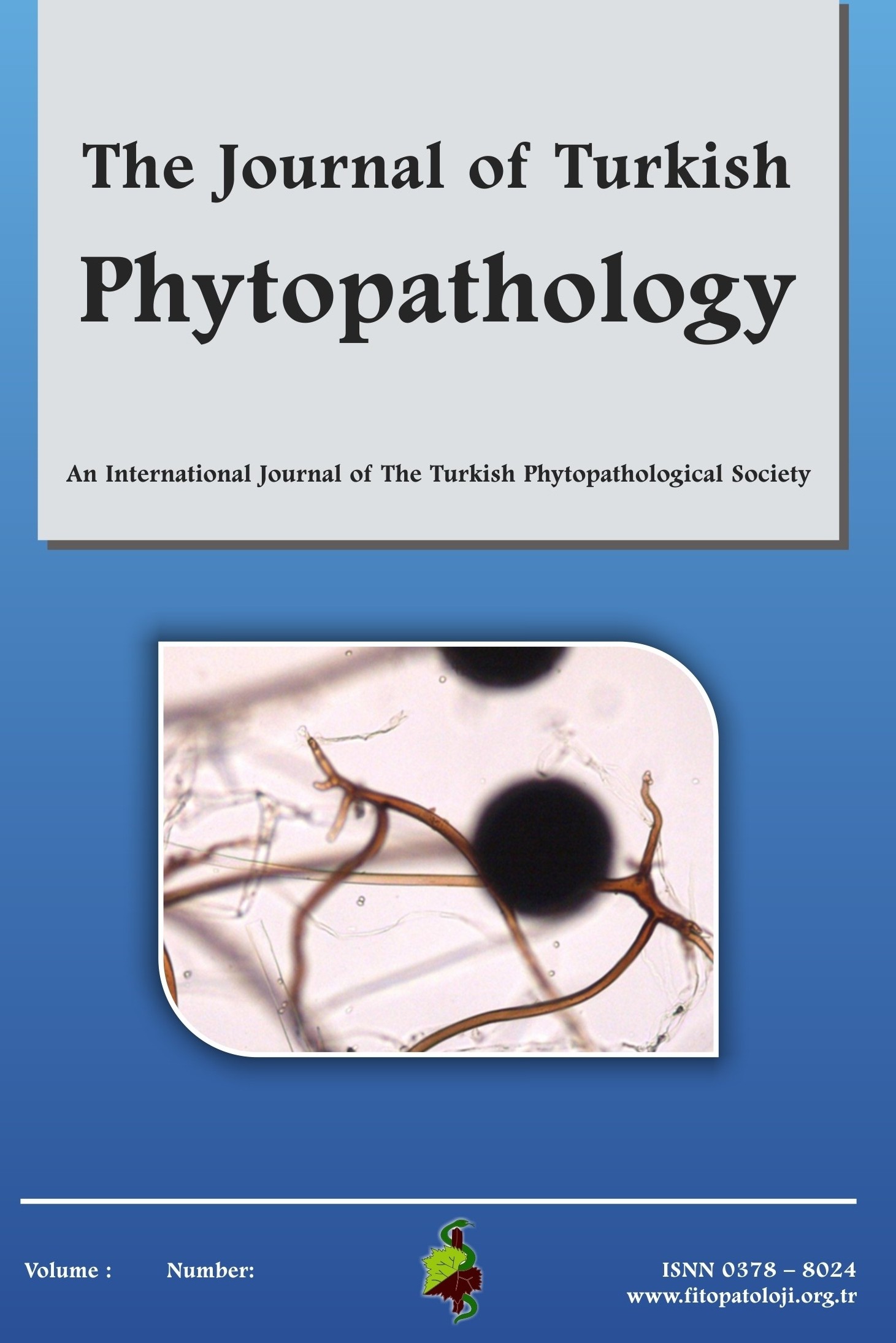Türkiye’de Pervane Çiçeğinde (Catharanthus roseus L.) Kök ve Kök Boğazı Çürüklüğüne Neden Olan Rhizoctonia solani AG-4’ün İlk Tespiti
Anavatanı Madagaskar olan pervane çiçeği (Catharanthus roseus L.) tek yıllık, çiçekli ve otsu özellikteki bir süs bitkisidir. Bu bitki park ve bahçeler için peyzaj amaçlı kullanılmaktadır. Pervane çiçeğinde sorun olan en önemli hastalıkların başında Rhizoctonia solani’nin neden olduğu gövde, kök ve kök boğazı çürüklüğü hastalığı gelmektedir. İzmir ilinde pervane bitkisinin yetiştirildiği alanlarda hastalıkla ilgili sorunlar gözlenmiştir. Bu nedenle 2017 yılında İzmir ili Bornova ve Bayındır ilçesinden hastalıklı bitki örnekleri toplanmış ve yapılan izolasyonlar sonucunda R. solani izolatları elde edilmiştir. Patojenisite testi sonucunda izolatların pervane çiçeğinde kök ve kök boğazı çürüklüğüne neden olduğu belirlenmiştir. Elde edilen izolatların morfolojik ve moleküler olarak tanılanması sonucu 5 adet R. solani AG-4 izolatı saptanmıştır. Bu çalışma sonucunda tespit edilen R. solani AG-4 pervane çiçeği bitkisinde Türkiye için ilk kayıttır.
Anahtar Kelimeler:
Catharanthus roseus, patojenisite, pervane çiçeği, Rhizoctonia solani AG-4
First report of Rhizoctonia solani AG-4 causing root and crown rot on Madagascar periwinkle (Catharanthus roseus L.) in Turkey
Madagascar periwinkle (Catharanthus roseus L.) is an is annual, flowering and herbaceous ornamental plant originated in Madagascar. It is used for landscaping for parks and gardens. One of the most important disease in this plant is stem, root and crown rot caused by Rhizoctonia solani Kuhn. Disease-related problems on the plants have been observed in growing areas in İzmir. For this reason, infected plant samples were collected from Bornova and Bayındır district in İzmir and R. solani isolates were obtained. As a result of the pathogenicity tests, all the isolates caused root and crown rot on Madagascar periwinkle. According to morphological and molecular identification methods, 5 R. solani AG-4 isolates were determined. This is the first report of R. solani AG-4 of Madagascar periwinkle in Turkey.
___
- Aiello, D., Guarnaccia, V., Formica, P.T., Hyakumachi, M. and Polizzi, G. 2017. Occurrence and characterisation of Rhizoctonia species causing diseases of ornamental plants in Italy. European Journal of Plant Pathology, 148(4), 967-982.
- Aslam, J., Khan, S.H., Siddiqui, Z.H., Fatima, Z., Maqsood, M., Bhat, M.A., Nasim, S.A., Ilah, A., Ahmad, I.Z., Khan, S.A., Mujib, A. and Sharma, M.P. 2010. Catharanthus roseus (L.) G. Don. An important drug: it’s applications and production. Pharmacie Globale (IJCP) 4:1–16.
- Carling, D.E., Baird, R.E., Gitaitis, R.D., Brainard, K.A. and Kuninaga, S. 2002. Characterization of AG-13, a newly reported anastomosis group of Rhizoctonia solani. Phytopathology, 92(8), 893-899.
- Castano, R., Scherm, B. and Aviles, M. 2014. Genetic diversity of Fusarium oxysporum f. sp. dianthi in Southern Spain. Journal of Mycology, 14 pages.
- Formica, P. T. 2015. Molecular characterization of Rhizoctonia spp. isolates and sustainable approaches to control Rhizoctonia diseases in ornamental nursery. Plant Health Technologies and Protection of Agroecosystems. Doctor of Philosophy, University of Canatia, Italy, 132 pages. Garibaldi, A., Bertetti, D. and Gullino, M.L. 2006. First report of leaf blight caused by Rhizoctonia solani AG1B on Madagascar periwinkle (Catharanthus roseus) in Italy. Plant Disease, 90 (10): 1361.
- Garibaldi, A., Bertetti, D. and Gullino, M.L. 2009. First report of Leaf Blight on hoşta fortunei caused by Rhizoctonia solani AG 4 in Italy. Plant Disease, 93(4): 432.
- Garibaldi, A., Tabone, G., Bertetti, D. and Gullino, M.L. 2020. First report of Rhizoctonia solani AG-4 HG-I causing crown rot on Abelmoschus manihot in Italy. Journal of Plant Pathology, Diseases note.
- Hao, W., Richardson, P. A. and Hong, C. X. 2010. Foliar blight of annual vinca (Catharanthus roseus) caused by Phytophthora tropicalis in Virginia. Plant Disease, 94(2), 274-274.
- Holcomb, G. E. 2000. First Report of Sclerotium rolfsii on Catharanthus roseus. Plant disease, 84 (2), 200.
- Holcomb, G.E. and Carling, D.E. 2002. First report of web blight caused by Rhizoctonia solani on Catharanthus roseus in Louisiana. Plant Disease, 86 (11):1272.
- Latuf, A.A. 2019. Alternaria alternata causes leaf blight of rosy periwinkle (Catharanthus roseus) in Iraq. 2019. Australasian Plant Disease Notes, 14: 4.
- Moromizato, Z. I. 1997. Mycological and phytopathological studies on Rhizoctonia solani Kuhn. Science Bulletin-College of Agriculture University of The Ryukyus, 1-80.
- Nejat, N., Valdiani, A., Cahill, D., HowTan, Y., Maziah, M. and Abiri, R. 2015. Ornamental exterior versus therapeutic interior of Madagascar periwinkle (Catharanthus roseus): the two faces of a versatile herb, Scientific World Journal, pp. 119.
- Priyatmojo, A., Yotani, Y., Hattori, K., Kageyama, K. and Hyakumachi, M. 2001. Characterization of Rhizoctonia spp. causing root and stem rot of miniature rose. Plant Disease, 85:1200-1205.
- Sneh, B., Burpee, L. and Ogoshi, A. 1991. Identification of Rhizoctonia species. American Phytopathological Society Press, 133, Minnesota.
- Sneh, B., Jabaji-Hare, S., Neate, S. and Dijst, G. 1996. Rhizoctonia species: Taxonomy, molecular biology, ecology, pathology and diseases control. Springer Science & Business Media, 578, Netherland.
- Tepedelen, G. ve Karagöz, C., 2014. İzmir İli’nde Bazı Süs Bitkilerinde Görülen Fungal Hastalıklar. V. Süs Bitkileri Kongresi Bildirileri, Yalova. 1/ 294-300s.
- Townsend, G. K. ve Heuberger, J. W. 1943. Methods for estimating losses caused by diseases in fungicide experiments. Plant Disease Reporter, 27, 340-343.
- Türkkan, M. ve Karaca, G. 2006. Amasya İli Soğan Ekiliş Alanlarında Bulunan Fungal Kök Çürüklüğü Hastalık Etmenlerinin Belirlenmesi. Tarım Bilimleri Dergisi, 12 (4) :357-363.
- White, T. J., Bruns, T. D., Lee, S. and Taylor, J. W. 1990. Amplification and direct sequencing of fungal ribosomal RNA genes for phylogenetics. In: Innis MA, Gelfand DH, Sninsky J, White TJ (eds), PCR Protocols: a Guide to Methods and Applications. Academic Press, 315–322, San Diego.
- ISSN: 0378-8024
- Yayın Aralığı: Yılda 3 Sayı
- Başlangıç: 1971
- Yayıncı: Türkiye Fitopatoloji Derneği
